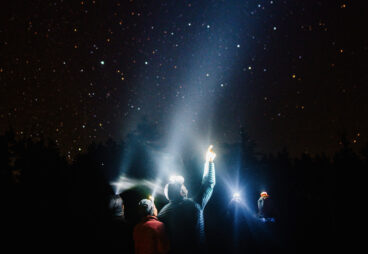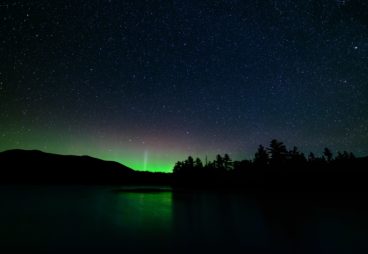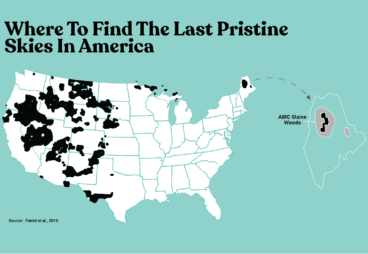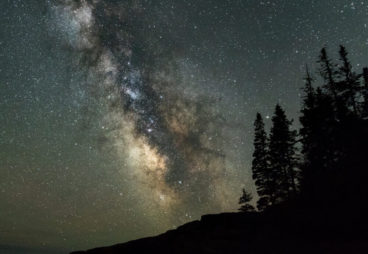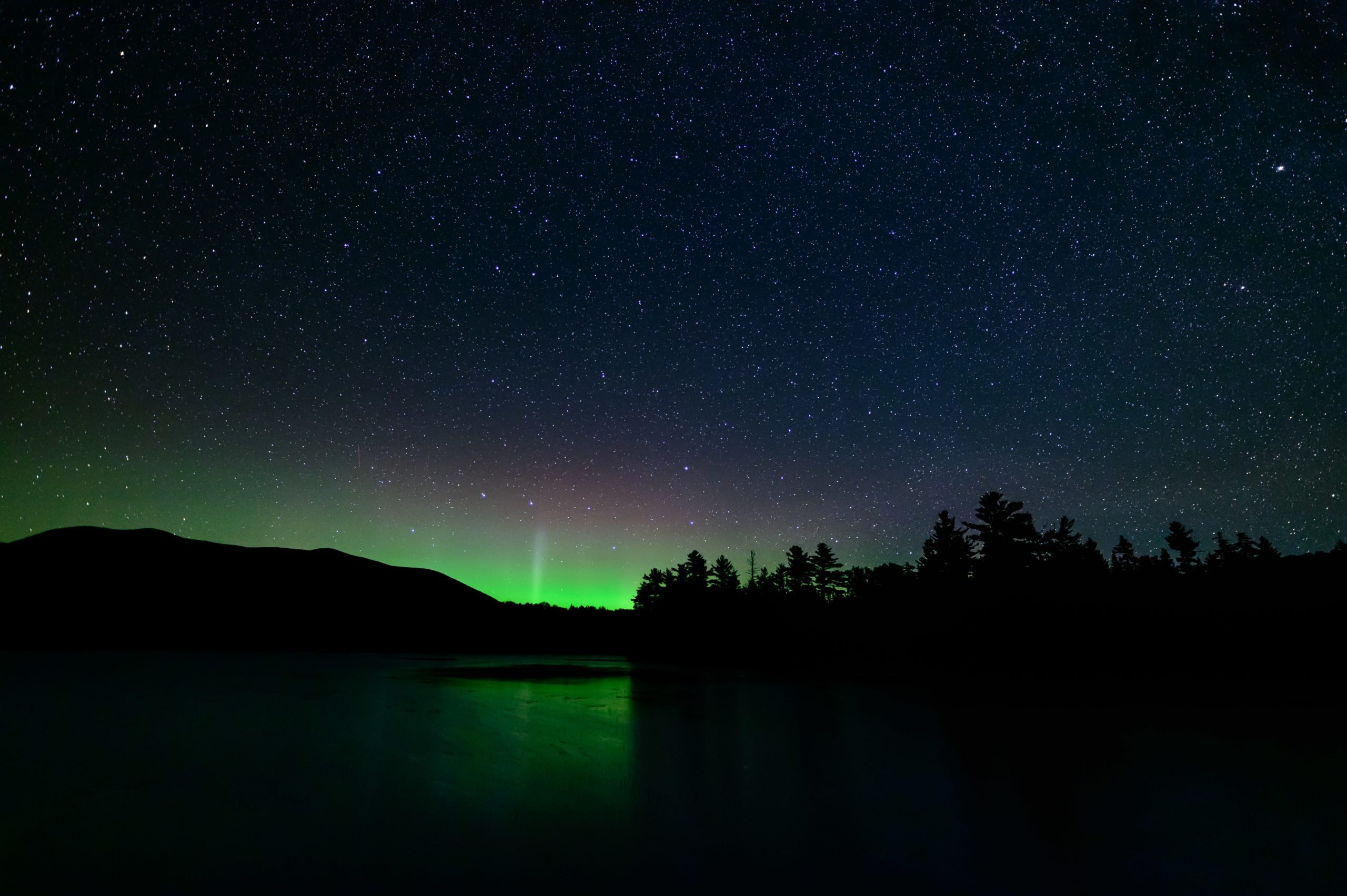
AMC Maine Woods International Dark Sky Park
Experience the best stargazing in New England.
The AMC Maine Woods International Dark Sky Park is the first and only International Dark Sky Park in New England. Consistent with our conservation mission, protecting dark skies enhances human and ecological health. And due to its exceptional dark skies, the Park is one of the best places for stargazing in the region.
Get ready to see the dark! Learn how AMC is working towards a darker night sky.
About Dark Skies
The AMC Maine Woods International Dark Sky Park lies at the edge of the North Maine Woods, an expanse of more than 14,000 square kilometers of largely uninhabited forest land that stretches from Monson, Maine, to the border of Canada. This region is one of the darkest places remaining on the East Coast and has also been identified as an area of exceptionally high habitat connectivity and climate change resilience.
This video was prepared by AMC using Federal funds under award 01-79-15159/URI:11815 from the US EDA, of U.S. Department of Commerce. The statements, findings, conclusions, and recommendations are those of the author(s) and do not necessarily reflect the views of the EDA, or the U.S. Department of Commerce.
The Dark Sky Park certification is given by DarkSky to land possessing an exceptional quality of starry nights and a nocturnal environment that is specifically protected for its scientific, natural, educational, and cultural heritage, and/or public enjoyment. Because most of the eastern United States has light pollution that prevents pristine views of the night sky, there are only a limited number of International Dark Sky Parks on the East Coast.
A dark sky is one where artificial light does not interfere with the view of the natural starry environment. 100 years ago, anyone could look up at the night sky and see thousands of stars above, but due to the increased and widespread use of artificial light over the last century 80 percent of the world’s population lives under skyglow, and in the United States and Europe 99 percent of the public can’t experience a natural night.
The conservation benefits of limiting excess artificial light include:
- Reducing deaths of migratory birds, turtles, and other species who interact with the natural night sky
- Improving wildlife habitat, including supporting natural pollination of plants and recovery of plant and tree species
- Reducing the pollution associated with energy production
- Immediately returning visibility of the stars in the night sky
There are broader benefits to reducing light pollution as well, including:
- Saving homeowners, municipalities, and businesses on energy costs
- Reducing glare, which improves street safety
- Reducing serious health effects, like certain cancers, diabetes, and obesity
- Providing science education and light pollution awareness through dark sky programming
- Opening the door to establish an astro-tourism economy in the region
- Talk to others about the benefits of dark skies and risks of light pollution
- Participate in community science. There are a number of ways to measure and upload information to share with the world related to dark skies
- Support good outdoor lighting policies in your town, rehab poor-quality outdoor lighting installations at your home or business, and reach out to educate neighbors and visitors on the importance of dark skies
- Sign up for alerts to our calls to action at outdoors.org
- Donate, join, volunteer, advocate
Learn more about dark sky conservation at darksky.org.
Stay Under the Dark Sky with AMC
Sleep beneath a sky full of stars! At AMC’s Maine lodges, the best view is above you. Nestled within a Dark Sky Park, these remote locations offer a pristine night sky like no other. Join us for celestial programming, or simply gaze upward and be amazed. Beyond stargazing, our lodges are the gateway to hundreds of miles of gravel trails, world-class fly fishing, family-friendly hikes, numerous paddle sports, and endless cross-country ski trails in the winter. Adventure awaits at every turn!
Medawisla Lodge and Cabins
Gorman Chairback Lodge and Cabins
Little Lyford Lodge and Cabins
Dark Sky Resources
Stars in Our Eyes: AMC’s 2025 Skygazing Guide, Part 1
We’ll be the first to admit we’re a bit starry-eyed. From Virginia to Maine, you can often find us outside with our heads tilted up, trying to get a...
ExploreHow to Protect the Night Sky
Light pollution is a widespread problem that is associated with many threats to human health and the environment, from disrupted circadian rhythms and insomnia to habitat destruction. Many environmental...
ExploreWhat Is a Dark Sky?
When you look at the sky at night, what do you see? Until a few generations ago, people everywhere saw the same thing. A sky filled with stars, planets,...
ExploreSee the Dark: Exploring Maine’s International Dark Sky Park
One of the best-kept secrets of our Maine Woods destinations is the incredible stargazing opportunities that exist due to its exceptional dark skies. This region is one of the...
ExplorePreserving the Dark Skies of the Maine Woods
AMC’s Maine Woods holds a unique role in the preservation of night sky—nestled within a more secluded part of northern Maine, it’s in the heart of one of few remaining...
ExploreStargazing: How and Where to Go to See the Stars
From his backyard in Augusta, Maine, astronomer Jon Silverman can look into the night sky and see light emitted from stars hundreds, thousands, even millions of years ago. Anyone can....
ExploreDark Sky Classroom Program
As part of AMC's “See the Dark” initiative, we have worked with educators to develop an easy-to-implement, three-day mini-unit to help students learn about light pollution and the benefit of dark skies.
The program is designed to be turn-key, fun, and educational. It is based on NGSS standards and designed to introduce students to light pollution, the negative effects it can have on living things, and possible solutions. It is a three-day unit with each day consisting of a 60-minute class period. Times can be adjusted to meet school-specific needs.





